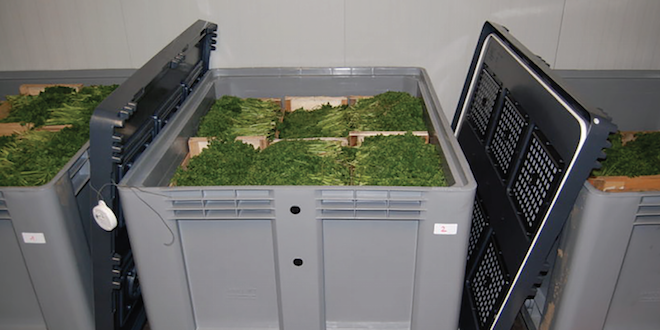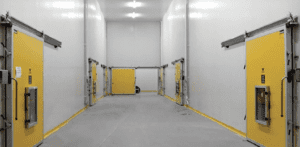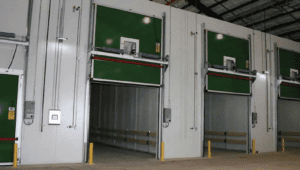

Jun 17, 2020Food industry, cold storage shift with online demand
The food industry, including produce, is undergoing significant disruption from COVID-19, as U.S. consumers increasingly have groceries delivered directly to their homes (D2C) or are buying online and picking up in store (BOPIS).
CBRE Group Inc., a Fortune 500 and S&P 500 company headquartered in Los Angeles, is is a large commercial real estate services and investment firm. CBRE reports that, according to Adobe’s Digital Economy Index, the U.S. grocery industry had a 100% increase in daily online sales between March 13 and 15, compared with the baseline period of March 1 to 11. Furthermore, a Brick Meets Click/Shopper Kit survey found that 46% of respondents will continue to purchase goods online after the pandemic subsides.
Considering that 95% of food produced in or imported to the U.S. goes through third-party distribution centers before reaching consumers, this shift undoubtedly will impact the cold storage sector. CBRE Research explored the relationship between e-commerce grocery growth and cold storage warehouse capacity in its “Food on Demand Series: Cold Storage Logistics Unpacked” report, concluding that an additional 75 million to 100 million square feet of freezer/cooler space will be needed to meet demand for D2C food delivery and BOPIS. The COVID-19 pandemic is accelerating this trend.
Although they typically dictate how frequently consumers eat out, economic conditions don’t dramatically impact the demand for cold storage space either way. Food moves in and out of warehouses whether its destination is a restaurant, grocery store or the consumer. Since restaurants are down to 10% to 20% of capacity and are only fulfilling delivery orders, there’s been a shift to grocery that has forced distributors to adjust supply chains. U.S. food sales have risen steadily since 2000 except for a minor blip in 2009, including food purchased in grocery stores and restaurants. Although the near-term impact is a decrease in restaurant sales, grocery sales likely will have a disproportionate uptick in 2020.
CBRE reported public refrigerated warehouse companies (PRWs) and online grocers have seen a surge in demand as consumers shelter in place. There has been a corresponding uptick in short-term requirements for freezer/cooler space – anywhere from three months to one year. Nevertheless, companies are waiting to make long-term real estate decisions and focusing on keeping employees safe and healthy during this disruptive period.


Looking ahead, the long-term effects of COVID-19 will change the cold storage sector in five critical ways:
1. E-commerce grocery will become more widely adopted. Given the increase in online grocery shopping, there will be heightened demand for cold storage capacity; however, the volume of perishable orders will need to grow in order to have a significant impact on cold storage real estate decisions. In general, there is a recent consumption trend toward food that drives demand for temperature-controlled space, like frozen meat and processed poultry. Until recently, consumers were not ordering a lot of perishables online, but that likely will change in a post-COVID-19 environment.
2. Since e-commerce is typically fulfilled by local grocery stores, retail footprints will include more storage and fulfillment space. As online orders rise, there will be a blending of retail and industrial space, as well as a greater need for infill temperature-controlled facilities in proximity to consumers. Space requirements will vary among food retailers, but additional modern space likely will be needed considering that the average age of cold storage warehouses is 34 years.
3. Restaurants may see a significant shift in dining formats with less dine-in options and more delivery or take-out that would require cold storage capacity. Foodservice companies that supply restaurants may look to second-generation cold storage space as a cost advantage in a limited dining environment.
4. There will be further consolidation among major PRWs to gain more control over the cold storage footprint in the U.S. This will lead to specialized development in major metros where large cold storage operators will partner with developers to strategically build a network in proximity to population clusters.
5. Automation will increase in cold storage facilities to efficiently fulfill orders and make up for a shortage of workers willing to work in the extreme conditions of these facilities. This will prompt higher-density, greater-height and smaller-footprint buildouts that will be required for around-the-clock operations.


Detecting the threat
How long can the virus survive in cold environments? Researchers from the National Institute of Health, Centers for Disease Control and Prevention, UCLA and Princeton University examined how long COVID-19 survives in the air as well as on copper, cardboard, plastic and stainless steel and then compared it with SARS, the coronavirus that emerged in late 2002 and killed nearly 800 people.
Related: Cold storage safety tips during COVID-19
They found that COVID-19 was detectable in aerosols for up to three hours, up to four hours on copper and up to 24 hours on cardboard. The new coronavirus can also last up to three days on plastic and stainless steel, the scientists concluded, adding the amount of the virus left on those surfaces decreases over time. Aerosols are solid or liquid particles that hang in the air, including fog, dust and gas commonly used in medical procedures like ventilation and nebulizers. This study was done in ambient temperature conditions.
Studies on the survivability of COVID-19 at lower temperatures have not yet been completed. Similar types of viruses can survive longer at lower temperatures, and years in the frozen state.
— Gary Pullano, managing editor














